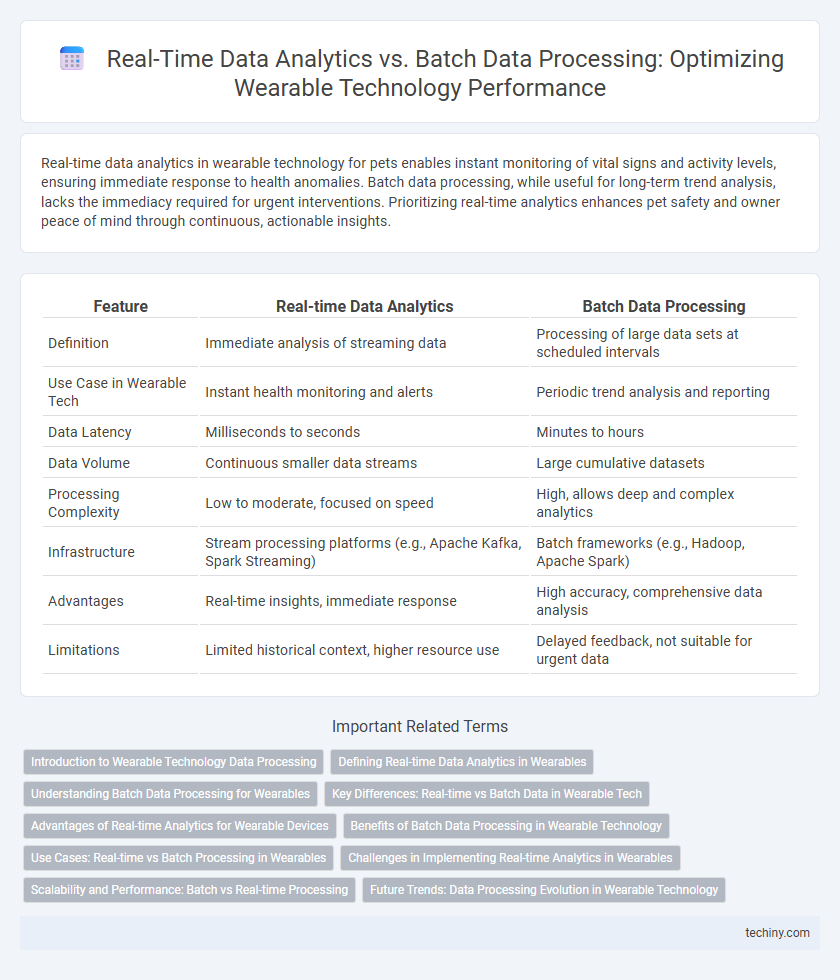Real-time data analytics in wearable technology for pets enables instant monitoring of vital signs and activity levels, ensuring immediate response to health anomalies. Batch data processing, while useful for long-term trend analysis, lacks the immediacy required for urgent interventions. Prioritizing real-time analytics enhances pet safety and owner peace of mind through continuous, actionable insights.
Table of Comparison
| Feature | Real-time Data Analytics | Batch Data Processing |
|---|---|---|
| Definition | Immediate analysis of streaming data | Processing of large data sets at scheduled intervals |
| Use Case in Wearable Tech | Instant health monitoring and alerts | Periodic trend analysis and reporting |
| Data Latency | Milliseconds to seconds | Minutes to hours |
| Data Volume | Continuous smaller data streams | Large cumulative datasets |
| Processing Complexity | Low to moderate, focused on speed | High, allows deep and complex analytics |
| Infrastructure | Stream processing platforms (e.g., Apache Kafka, Spark Streaming) | Batch frameworks (e.g., Hadoop, Apache Spark) |
| Advantages | Real-time insights, immediate response | High accuracy, comprehensive data analysis |
| Limitations | Limited historical context, higher resource use | Delayed feedback, not suitable for urgent data |
Introduction to Wearable Technology Data Processing
Wearable technology data processing relies on real-time data analytics to provide immediate insights from continuous sensor inputs, enhancing user experience through instant feedback and adaptive responses. Batch data processing handles large volumes of historical data from wearables, enabling in-depth trend analysis and long-term health monitoring but lacks the immediacy needed for real-time applications. Combining these methods optimizes performance, balancing prompt decision-making with comprehensive data evaluation for wearable devices.
Defining Real-time Data Analytics in Wearables
Real-time data analytics in wearable technology refers to the continuous processing and analysis of data as it is generated by sensors embedded in devices like smartwatches and fitness trackers. This approach enables immediate feedback, enabling features such as heart rate monitoring, activity tracking, and health alerts with minimal delay. Unlike batch data processing, which handles data in large groups at scheduled intervals, real-time analytics supports instantaneous decision-making crucial for health and performance monitoring.
Understanding Batch Data Processing for Wearables
Batch data processing in wearable technology involves collecting and storing data over a period before processing it in large volumes, optimizing resource use and battery life. This method suits scenarios where immediate feedback is not critical, such as analyzing long-term health trends or sleep patterns from fitness trackers. By aggregating data, batch processing enables comprehensive insights without continuous power consumption, making it ideal for wearables with limited processing capabilities.
Key Differences: Real-time vs Batch Data in Wearable Tech
Real-time data analytics in wearable technology processes data instantly as it is generated, enabling immediate insights for health monitoring and activity tracking. Batch data processing collects and analyzes data over a set period, making it suitable for long-term trends and retrospective analysis but ineffective for time-sensitive decisions. Wearable devices prefer real-time analytics for critical applications like heart rate monitoring, while batch processing supports large-scale data aggregation for research and development.
Advantages of Real-time Analytics for Wearable Devices
Real-time data analytics enables wearable devices to provide instant health monitoring and immediate feedback, crucial for timely decision-making and emergency response. This continuous data stream enhances personalized user experiences by detecting anomalies and adapting functionalities on the fly. Unlike batch data processing, real-time analytics supports dynamic tracking of vital signs, improving accuracy and user engagement in fitness and medical applications.
Benefits of Batch Data Processing in Wearable Technology
Batch data processing in wearable technology enables efficient analysis of large volumes of data collected over extended periods, reducing system resource consumption. This method enhances data accuracy and reliability by allowing comprehensive validation and error correction before processing. Batch processing supports long-term trend analysis and complex computations, crucial for health monitoring and personalized fitness insights.
Use Cases: Real-time vs Batch Processing in Wearables
Real-time data analytics in wearable technology enables continuous health monitoring, immediate fitness feedback, and instant detection of medical emergencies like arrhythmias or falls, enhancing user safety and personalized care. Batch data processing supports long-term trend analysis, sleep pattern evaluation, and periodic health assessments by aggregating data over days or weeks for comprehensive insights. Balancing these approaches allows wearables to provide both timely alerts through real-time analytics and in-depth health evaluations via batch processing.
Challenges in Implementing Real-time Analytics in Wearables
Implementing real-time data analytics in wearable technology faces significant challenges including limited device processing power, which restricts on-device data analysis capabilities, and constrained battery life that demands energy-efficient computational methods. Continuous streaming of vast sensor data requires robust connectivity and low-latency networks, often complicated by variable environmental conditions and user mobility. Ensuring data privacy and security during real-time transmission further complicates integration, requiring sophisticated encryption and compliance with healthcare regulations such as HIPAA.
Scalability and Performance: Batch vs Real-time Processing
Real-time data analytics in wearable technology enables immediate processing and analysis of continuous streams of health and activity data, optimizing performance for real-time decision-making and personalized feedback. Batch data processing, while scalable for large datasets, often suffers from latency issues, limiting its effectiveness in scenarios requiring instant insights or rapid response. The scalability of real-time processing is achieved through distributed computing and edge analytics, ensuring wearables maintain responsiveness without sacrificing accuracy or speed.
Future Trends: Data Processing Evolution in Wearable Technology
Real-time data analytics in wearable technology enables instantaneous health monitoring and personalized feedback, enhancing user experience and proactive health management. Future trends indicate a shift toward edge computing and AI integration, allowing data to be processed directly on wearable devices to reduce latency and improve energy efficiency. Emerging batch processing methods will complement real-time analytics by handling large-scale data aggregation for longitudinal health insights and predictive modeling in fitness and medical applications.
Real-time Data Analytics vs Batch Data Processing Infographic

 techiny.com
techiny.com